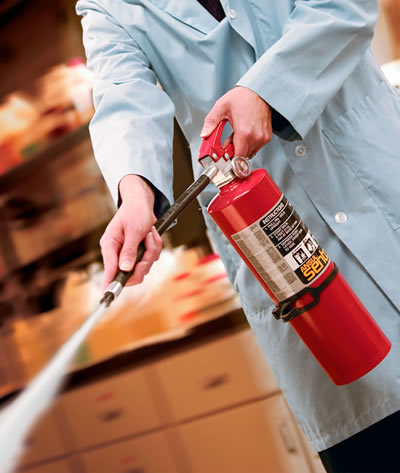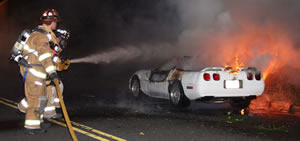Hot Issue: Automotive Fire Extinguishers - Page 1 of 4
by Hib Halverson
© November 2012
No use without permission, All Rights Reserved

What if a fire started in your Corvette?
Got your attention, huh.
The National Fire Protection Association (NFPA) tells us that, in 2011, the last year statistics are available, there were 219,000 vehicle fires in the U.S.-about one every 2 1/2 minutes. Those fires killed 300 people, injured 1190 and did 1.4 billion dollars worth of damage.
Some believe vehicle fires are caused mainly by gasoline or other flammable liquids. According to a June 2010 NFPA study of “US Vehicle Fire Trends and Patterns,” during a four-year period, 2003-2007, only 2% of vehicle fires started in the fuel system. Another 3% percent were caused by collisions or rollovers. The study reveals that nearly 75% of the fires were caused by mechanical failures or electrical problems and two-thirds of them began in the engine, drivetrain, or wheel areas. Those fires resulted in 35% of the deaths, 46% of the injuries, and 53% of the property damage.
Now that you have some stats, how 'bout a few more questions?
Confronted with fire in your Corvette, garage or workshop; do you know what to do, first? Do you have a fire extinguisher? Do you know what kind of fires it can put out? Last, but certainly not least: do you know how to use that extinguisher?
One last fact-NFPA tells us that a third of vehicle fire injuries were to people who tried to fight the fire themselves. Clearly, folks who use fire extinguishers need to be better educated about putting out fires.
The Fours of Fire
Just what is “fire,” anyway?
It's rapid oxidation of a combustible material-gasoline, oil, exterior body panels, underhood plastic or rubber parts, insulation on electrical wiring, interior trim, upholstery, tires and parts made of certain metals-releasing heat, light, and reaction products such as smoke, sparks or embers.
A fire has four components, an idea illustrated by the “fire tetrahedron.” The four parts are: heat, oxygen, fuel and a chemical chain reaction. Eliminate one or more of those four-there’s no fire. If you cool the fuel below its ignition temperature, take away the oxygen, remove the fuel or interfere with the chain reaction; the fire goes out.
Fires are categorized into five classes and four of them may occur in vehicles or garages.
“Class A” fires are fueled by wood, paper, plastic, rubber, cloth, upholstery and similar materials.
“Class B” fires are fueled by flammable liquids or gases.
“Class C” fires are fueled by or burn on or in electrical equipment which is energized or “live”. A Class C fire will be a Class A fire or, occasionally, a Class B fire, with what’s burning, also, being electrically charged.
“Class D” fires are fueled by combustible metals. One example is magnesium, used in some C5 wheels along with some C6 chassis parts and, occasionally, in underbody structure. Complete masses of combustible metal are usually not significant fire risks because they conduct heat away from hot spots so well that combustion is not sustainable, i.e.: it requires a lot of heat to set a mag wheel on fire. Metal fire risks are far greater when sawdust, machine shavings and other fine metal powder or debris are present. For example: aluminum powder is highly flammable-that's why it's sometimes called "flash" powder.


